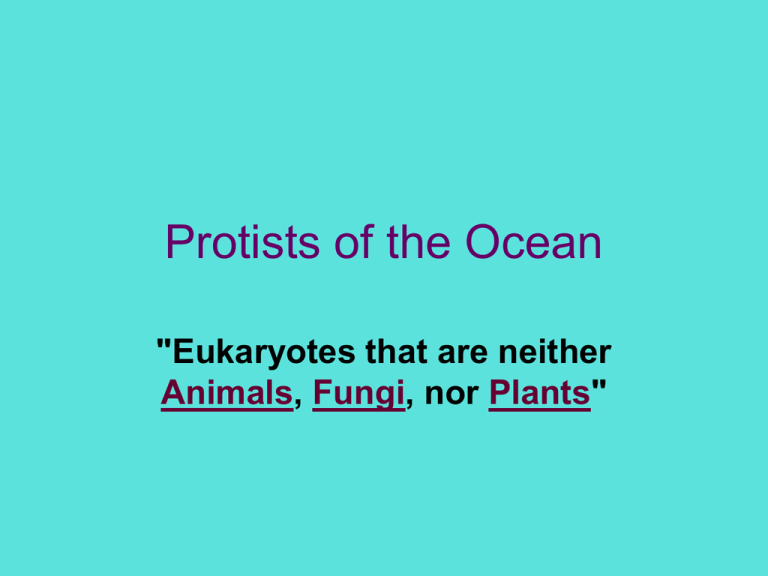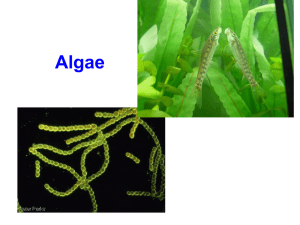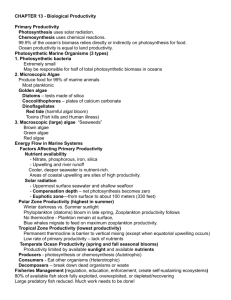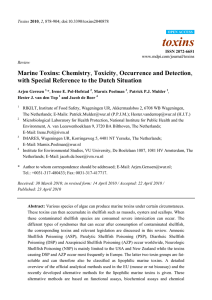Protists of the Ocean
advertisement

Protists of the Ocean "Eukaryotes that are neither Animals, Fungi, nor Plants" Ameoba with ingested Diatoms Paramecium Lunch! Plant like Protists Autotrophic oxygen producers • Euglena • Algae – Single celled • Phytoplankton – Cyanobacteria – Diatoms – Dinoflagellates – Multi-celled • Sea weeds Euglena • Has flagella • Mostly lives in fresh water • Has light sensitive red eyespot • Autotrophic and heterotrophic Phytoplankton: Ocean Food! • Derived from the Greek words phyto (plant) and plankton (made to wander or drift), phytoplankton are microscopic organisms that live in watery environments, both salty and fresh. • Some phytoplankton are bacteria, some are protists, and most are single-celled plants. Among the common kinds are cyanobacteria, silica-encased diatoms, dinoflagellates, green algae, and chalk-coated coccolithophores. Algae: single celled • Prokaryotic – Cyanobacteria • Single-celled to filamentous blue-green alga or cyanobacterium • Photosynthetic • Produce much of the oxygen in the world Life in a Glass House • Diatoms – Most abundant of single celled protists – Account for 20% of photosynthesis – Silica shells make them great fossils to study Dinoflagellates • The term "dinoflagellate" means "whirling flagella" • Each has two flagella • Most are photosynthetic • Some are parasitic • Can cause problems with “blooms” • Red tide – produce a neurotoxin which affects muscle function in susceptible organisms. – Humans may be affected by eating fish or shellfish containing the toxins. – paralytic shellfish poisoning, or PSP (from eating affected shellfish, such as clams, mussels, and oysters) – serious but are not usually fatal. Seaweed • Seaweeds are algae that live in the sea or in brackish water. Scientists often call them "benthic marine algae", which just means "attached algae that live in the sea". • There are about 10,000 species of seaweeds • three basic colors: red, green, and brown – Red and Brown are in salt water – Green often in fresh water Conjugation – Sexual Reproduction Filamentous Green Alga Colonial Algae Multicellular Green Algae Kelp Forests kelp forest web cam Detrimental Aspects of Algae • • • • Blooms of freshwater algae Red tides and marine blooms Toxins accumulated in food chains Damage to cave paintings, frescoes, and other works of art • Fouling of ships and other submerged surfaces • Fouling of the shells of commercially important bivalves Red tide bloom • Prorocentrum micans bloom • Associated with Hurricane Floyd, which ended a dry summer • surface of water slick with this dinoflagellate Algal Bloom: Before and After Red tide Toxic Phytoplankton & Human poisoning • Paralytic shellfish poisoning - saxitoxin • Neurotxic shellfish poisoning - brevetoxin • Ciguatera fish poisoning - ciguatoxin and maitotoxin • Diarrhetic shellfish poisoning - okadaic acid • Amnesic shellfish poisoning - domoic acid • Cyanobacterial neurotoxins - anatoxins • Cyanobacterial hepatotoxins - microcystin, nodularin • Dermatitis - lyngbyatoxin, aplysiatoxin Benefits of Algae • used commercially for toothpastes, soaps, ice cream, tinned meats, fabric printing etc, • • • • • • • • • Food for humans Food for invertebrates and fishes in mariculture Animal feed Soil fertilizers and conditioners in agriculture Treatment of waste water Diatomaceous earth (= diatoms) Chalk deposits Drugs The total wholesale value of dried brown algae worldwide collected in the wild or cultivated is less than $100 million dollars. Brown Tide • Causes: – Species: golden-brown algae • Aureococcus anophagefferens, A. lanunensis – Changes in groundwater, nutrients • Impacts – Zooplankton lose their appetites and die – Reduced sunlight kills plants – Death of bivalves (mussels, scallops etc) • What can we do?: – Less fertilizers! Amnesic Shellfish Poisoning • Causes – Diatoms (Pseudo-nitzschia multiseries, Paustralis) • Impacts – Toxin- domoic acid causes permanent loss of short term memory and may be fatal – Shell fish, crabs, and fish may be affected – Sea lion, pelicans, and cormorants also • What to do? Diarrhetic Shellfish Poisoning • Causes – Phytoplankton like Dinophysis acuminata, D. fortii, and Prorocentrum lima • Impacts – Toxins: lots of them – Cause nausea, vomiting, abdominal pain and diarrhea – Affect mussels, oysters, scallops and the humans and mammals who eat them • What to do? Neurotoxic Shellfish Poisoning • Causes – Dinoflagellates: Karenia brevis • Impacts – Toxins produced brevetoxin which affects manatees, dolphins, oysters, fish, clams, and birds and humans by consumption or breathing in the sea foam containing the toxin – Causes diarrhea, vomiting, neurologic symptoms, and asthma-like symptoms. NO known antidote but most recover in a few days • What to do? Paralytic Shellfish Poisoning • Causes – Algae Alexandrium • Impacts – Toxin affects mussels, clams, crabs, oysters, scallops, herring, sardines, marine mammals, and birds, and humans – Symptoms include numbness, paralysis and respiratory failure. No known antidote and death may occur from respiratory arrest within 24 hours • What to do? Harmful Cyanobacterial Blooms • Causes – Excessive growths of cyanobacteria • Impacts – Toxins affect nerves, liver tissues in mammals, birds, fishes and invertbrates – Humans can be affected by inhaling toxins causing nausea, diarrhea, stomach pain, difficulty breathing, allergic reactions, skin irritation, liver damage, and neurologic symptoms – Increased turbidity so decreased light • What to do? Pfiesteria piscicida • Causes – dinoflagellate • Impacts – Flu like symptoms, skin rashes, memory loss in commercial fishermen and women. • What to do?








